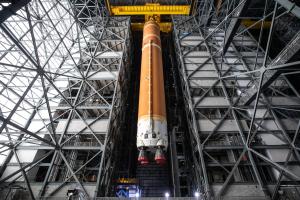Originally Published Nov. 10, 2003
Part I – The History of Skylab | Part III – The Legacy of Skylab
One of Skylab’s most important functions was to study the feasibility of long-duration space missions. As a result, the ongoing activity of astronauts just going about their daily lives in orbit was one of the greatest of all the scientific experiments aboard the station. Though they were free-falling in Earth orbit, traveling at 16,000 miles per hour, the Skylab crew members said that everyday life on the station was actually pretty normal.

Days began on Skylab at 6 a.m. (Houston time) and lasted until 10 p.m. At the beginning of each day, the astronauts would check the teletype machine to see what their orders were from Mission Control for that day. The crew would then use the restroom, weigh, and eat breakfast.
Their daily science assignments would rotate every day. Each took turns on things such as solar observation, and the astronaut who was the “guinea pig” for the medical evaluations one day would be performing those same evaluations on one of his crewmates the next.
“Between 8 and 10 at night, we had free time,” Carr said. “For the most part, the most fun was looking out the window.” Off-duty free time was often filled with still more science experiments. “We had a number of other things to do,” Garriott said. “We had the student experiments, for example.”
The crews also had fun devising their own small experiments, some of which were later turned into educational videos for students worldwide. Carr said he enjoyed this hobby. “It was such an interesting thing to turn loose a blob of water to see what you can do with it.” They also pulled a classic prank on mission controllers. The ground crew was shocked when Garriott’s wife, Helen, called down to them from the station. The roomful of controllers sat confused until the crew burst into laughter—Garriott had recorded his wife’s voice before the flight, and rehearsed the prank with capcom Bob Crippen.
Extra-vehicular activities (EVAs) had been scheduled from the beginning to change out the film in the Apollo Telescope Mount. However the EVAs eventually became necessary to repair the station. During the EVAs, Garriott said, it was a thrill to “look down this very long elevator shaft” to the surface of the Earth. “It’s quite an interesting view,” he said.

None of the astronauts expressed any concerns about the potential physical effects of the unprecedented spaceflight durations. Returning to Earth did take a little adjustment, though. In addition to a few days of readjusting to the physical effects of gravity, astronauts sometimes forgot that things do not work the same on Earth as they do in space, attempting to let things float as they would in microgravity.






























